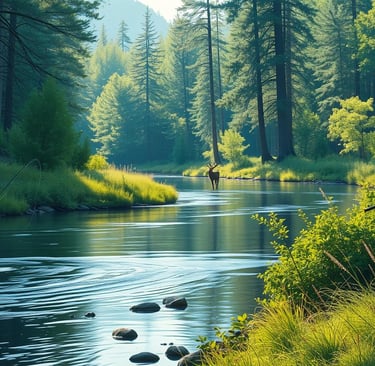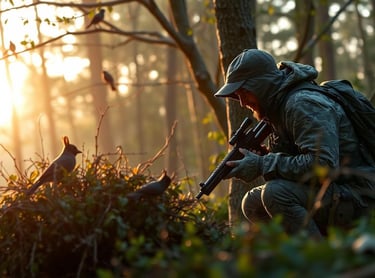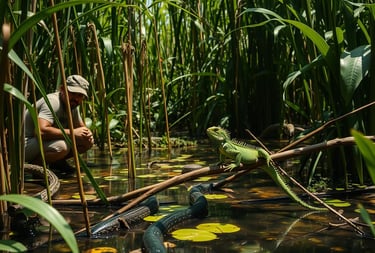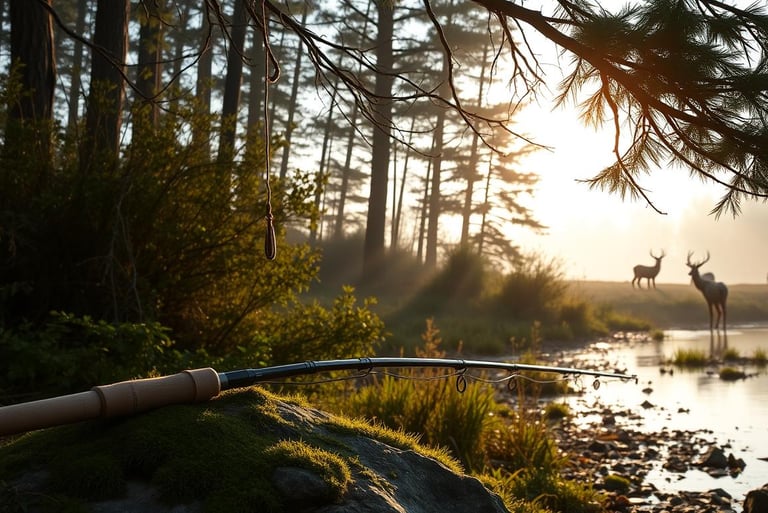Survival Guide: How to Hunt and Fish for Food
Learn essential survival skills for hunting and fish in the wilderness. Discover how to hunt and fish for survival, forage for food, and prepare game in Canada's rugged outdoors.
SURVIVAL POSTS
Kathrine-Anne Hill
10/19/202411 min read


Affiliate Disclosure:
Please note that some of the links in this article are affiliate links. This means that if you click on these links and make a purchase, I may receive a small commission at no additional cost to you. This commission helps support the maintenance and growth of this website and allows me to continue providing valuable information and recommendations. Rest assured, I only recommend products and services that I have personally used or thoroughly researched. Your support is greatly appreciated! For full disclosure see our Privacy Policy and Terms and Conditions here.
Imagine being far from home, with no modern comforts. Would you know how to find food in the wild? This guide will teach you how to hunt and fish. These skills are crucial for survival in harsh environments1.
Survival situations are very demanding. Wild animals offer quick energy to stay warm or cool1. Knowing how to hunt and fish can be life-saving outside.
Key Takeaways
Hunting and fishing are essential survival skills in remote wilderness situations.
Small game, fish, reptiles, and amphibians provide the most accessible wild meat sources.
Trapping techniques like snares and deadfalls are effective for small mammals and birds.
Harvesting fish through angling, nets, traps, spears, and bows offers a reliable protein source.
Properly cooking all wild game is crucial to eliminate harmful bacteria and parasites.
The Importance of Hunting and Fishing in Survival Situations
In the wilderness, small game, fish, reptiles, amphibians, and invertebrates are the best to hunt. They are plentiful and easy to catch, needing little technology to hunt2.
Concentrated Calories from Wild Animals
Wild animals provide a lot of calories, which is key in survival situations. These calories help keep the body warm and active2. Hunting sustainably keeps animal numbers balanced, benefiting the ecosystem3. Plus, selling animal fur can bring in extra money3.
Impact of Extreme Conditions on Energy Needs
Hunting and trapping can make you less reliant on store-bought food3. Knowing animal behavior and using camouflage increases your chances of catching food3. Choosing the right spot for traps is also crucial3.
"Hunting and fishing were not considered sports until recently. There has been a shift in how we view these activities."4
Tracking animals can give you insights into their behavior and whereabouts. This improves your hunting skills and success rates3. Setting snares and traps lets you catch animals passively, freeing you to do other things or rest3.
The ethics of hunting and fishing are still debated today4. The text encourages self-reflection and humility in these activities4. It urges people to think about the impact of their actions on the environment and wildlife4.
There are questions about the morality of causing pain to animals and capturing them as trophies4. The text talks about channeling primal urges through ethical and physical institutions4.
Small Game and Birds: Practical Options for Survival Hunting
Small game and birds are great for survival hunting. They are easy to find and can be eaten. Animals like raccoons, jackrabbits, and geese have a lot of meat5. But, bird numbers have dropped a lot because of lost habitats in the last 20 years5.
To hunt these animals well, you need to know where they go and what they eat. Knowing their size is also important.
Trapping Techniques: Snares and Deadfalls
Traps like snares and deadfalls work well for small animals6. Snares save time and energy. You can set up many snares to catch more animals6.
The best material for snares is wire. Copper strands are good if you have them6. If not, strong string or cord from 550 Parachute Cord works too6. Deadfalls use a heavy weight to kill the animal.
Throwing Weapons: Rocks, Sticks, Bows, and Atlatls
Using rocks, sticks, bows, and atlatls for throwing is useful6. They require practice but can be very effective. Bows and atlatls offer more power and precision than simple throws.
Small game and birds are good choices for survival hunting. Learning to use traps and throwing weapons helps. This way, you can find food even in tough places56.
Fish: A Fleshy and Abundant Source of Protein
Fish are a great source of protein in the wilderness. They are plentiful and full of nutrients7. You can catch them using various methods like hooks, spears, nets, and traps.
Angling with Improvised Hooks and Lines
Fishing with a hook and line is a useful skill. You can make hooks from bones, wood, or thorns7. Use plant fibers to make a line for your fishing rod7.
This setup lets you catch fish easily. It's a good way to get protein.
Spears, Nets, and Traps for Fishing
Spears and bows work well when you can see the fish8. Spears are good for catching one fish at a time. Nets catch more fish at once. Traps are easy to use and let you focus on other tasks7.
Learning different survival fishing techniques is key. This way, you can always have a steady supply of fish for survival. It's a big help in tough wilderness situations.
Reptiles and Amphibians: Overlooked but Nutritious
Reptiles and amphibians are often ignored, but they can be a great source of food in survival situations9. They may not be the first choice for hunting, but they pack a punch with calories and nutrients when other food is scarce.
Amphibians, like bullfrogs, need to be skinned before eating because their skin can be toxic10. But the meat inside is tasty and full of nutrients, making it a good addition to a survival diet. Reptiles, including turtles, lizards, and snakes, also offer high-quality protein. They can be caught using simple methods.
Turtles can be caught on baited hooks or in small weir-type traps.
Most lizards and snakes can be dispatched with a well-swung stick.
Reptiles and amphibians are crucial for a survival food plan9. They provide the energy and nutrients you need in hard times. With the right skills, they can be a lifesaver.
"Resting and active metabolic rates are generally higher for anurans compared to salamanders."10
Adding reptiles and amphibians to your survival skills can change the game9. Being open to new ideas and flexible can help you survive and even thrive in the wild.
How to Hunt and Fish for Survival
In a wilderness survival situation, hunting and fishing are key to getting food. Knowing about nature, how to make tools, and being adventurous can help. You can find plenty of food in the wild, like small animals, to keep you going11.
Fishing is a better choice than hunting for survival food11. Fish are easy to catch and kill for food11. You can make fishing gear like nets and spears from simple items like paracord and nails11.
For hunting, deadfalls and snares can catch small game and birds11. Parachute cord is excellent for making snares for animals like squirrels11. Gigging or spearing fish is an old method that takes practice11. You can also make fish traps or fish by hand11.
Staying calm and resourceful is key in survival situations12. Knowing how to make shelter, start a fire, and other survival skills can save your life12. With the right knowledge and tools, you can survive by using the wild's resources.
Invertebrates: A Protein-Rich Survival Food Source
When facing survival situations, finding diverse food sources is key. Insects, crustaceans, and mollusks are rich in protein. They can be a lifesaver when food is scarce13. Grasshoppers and crickets are abundant and full of protein, making them a common survival food13. Worms, grubs, and beetles can be found in soil or rotten wood, offering a lot of nutrition13.
The ocean, ponds, and rivers are full of edible invertebrates. Bivalves like clams and oysters, and crustaceans like crayfish and shrimp, are great sources of protein and minerals14. Mollusks like whelk are also good, and their tough shells can be cooked in coals before eating13.
Cooking and Preparing Invertebrates
Invertebrates can be easily added to your diet for survival. Insects and small creatures can be roasted, boiled, or ground into a meal. This meal can be mixed into soups or breads13. It's crucial to cook edible bugs before eating them to avoid parasites13.
"Invertebrates are a readily available and nutritious food source that can make all the difference in a survival situation."
Adding invertebrates to your survival diet can greatly increase protein and nutrient intake. Knowing where and how to prepare these creatures can help you survive when food is scarce1314.
Survival Hunting and Fishing Techniques
In a survival situation, you might need to make your own tools for hunting and fishing. Making fishing gear and using basic hunting tools can help you find food in the wild. You can make fishhooks from common items or use spears and traps to catch fish. These skills can be the difference between eating and going hungry.
Makeshift Fishing Hooks and Lures
You can make fishhooks from nails, safety pins, or even wood15. Gorge hooks, which let fish swallow bait, are another option15. If you don't have bait, you can make lures from shiny metal to attract fish16.
Spears, Gigs, and Traps for Fish
Spear fishing is a good choice in survival situations15. You can use sharpened sticks or branches to catch fish16. Traps made from wood and netting can also catch fish16. Weirs help guide fish to the trap15.
Hand fishing methods like noodling and graveling don't need tools15. Gill nets work well during fish migrations15. Cage traps and fish poison from plants can also be used15.
Knowing how to use these basic tools is key to successful survival hunting and fishing.
"Solo hunting is a common practice among enthusiasts, supported by the fact that about 71% of hunters occasionally prefer to hunt alone for various reasons, such as the desire to rely on personal skills and decisions in determining success."17
Planning, safety, and being prepared for emergencies are important for solo hunting and fishing. Studies show these are crucial17.
Foraging for Food in the Wilderness
Foraging is as crucial as hunting and fishing for survival. It's wise to focus on foods that are abundant, high in calories, and nutrients. This approach means you don't have to search for many different plants18.
Identifying Abundant Staple Foods
Finding wild plants safely is essential. Some plants look like others that are poisonous, like almonds and carrots. Knowing which is safe is crucial18. Also, what fruits are safe can change with the seasons18.
It's important to only take what you need. This helps keep the plants and the environment healthy18.
Rationing and Long-Term Planning
Planning how to use your foraged food is key. The wilderness can be full of food one day and empty the next18. Animals are most active at dawn and dusk, which is the best time to hunt and forage18.
In the past, people worked together to find, sort, and store food. This shows how teamwork is key to surviving in the wilderness18.
Foraging takes time and patience but gives you a sense of control. It's a way to appreciate real food in a world full of processed foods18. By finding and using staple foods wisely, you can survive and thrive in the wild19.
"Foraging for food requires time, patience, and skill, offering a sense of agency and capability along with a deeper appreciation for nutrition in an era of processed foods."
Survivalists can use the wild's resources to stay fed and navigate the wilderness well19. With the right skills and teamwork, you can survive and even thrive in harsh places20.
Conclusion
Learning wilderness survival skills is possible. Yet, living off the land is a huge challenge, even for experts23. A recent survey shows that hunting is less popular than ever, with most people accepting it only for food23.
Hunters and anglers are more accepted if they eat what they catch23. Planning, the right gear, and teamwork are key to surviving on your own24. Before this experience, the longest fast was 2 days, but survival scenarios usually last 3-4 days24.
With the right mindset, knowledge, and resources, you can survive using nature's bounty23. This requires a lot of skill and dedication, which many lack today23. The study suggests that hunting and eating wildlife can deeply connect us with nature23.
Hunting, fishing, and foraging are valuable survival skills24. They should be part of a broader strategy for dealing with extreme situations24. Hunting comes with risks, and fishing is the best way to get protein in survival situations24. A balanced approach, using various techniques and resources, is the best way to survive in the wilderness.
FAQ
Why are animal fats and proteins essential for survival in extreme conditions?
In extreme survival situations, our bodies burn calories faster to stay warm and do hard tasks. Wild edible animals provide concentrated calories. This helps keep our body's internal fire burning and gives us the energy we need.
What types of animals are the most practical and accessible to pursue for survival hunting?
For survival hunting, small game, fish, reptiles, amphibians, and invertebrates are best. They are easy to find, don't need much technology to catch, and offer a lot of meat and calories.
How can small game and birds be effectively hunted for survival?
Small game and birds can be caught with snares, deadfalls, or thrown weapons like rocks and sticks. Knowing their behavior and where they move is key to successful hunting.
What are some effective techniques for catching fish in a survival situation?
Fish can be caught with homemade hooks and lines, spears, nets, and traps. These methods make catching fish easy, so you can focus on other survival tasks.
How can reptiles and amphibians provide a valuable food source in the wilderness?
Reptiles and amphibians, like bullfrogs and turtles, are a good food source. They are common and can be caught with simple tools like baited hooks or sticks.
What are some ways to gather and prepare invertebrates for survival food?
Insects, crustaceans, and mollusks are full of protein and easy to find. They can be cooked in coals or ground into a meal to mix with other survival foods.
How can makeshift tools and primitive techniques be used for hunting and fishing in a survival situation?
In survival situations, you might need to make tools from what you find. Fishhooks can be made from nails or wood, and spears and traps can catch fish using basic materials.
Why is foraging for wild edible plants an important skill for long-term wilderness survival?
Foraging for wild foods is key for long-term survival. Finding and rationing staple foods is important to sustain yourself in the wilderness.
Source Links
Survival Hunting Tips » Wilderness Awareness School - https://wildernessawareness.org/articles/survival-hunting-tips/
How to Hunt and Fish Without the Necessary Tools - https://mountainhouse.com/blogs/hunting-angling/hunt-fish-without-necessary-tools?srsltid=AfmBOoobABjN8scNhI9qKcz-WjFLzUTcTZnUK40sSu0TjHL2ZciRYj24
Hunting and Trapping for Survival: 3 Ways to Success - natureofthenorth.co - https://natureofthenorth.co/basics/hunting-and-trapping-for-survival/
Mountain Journal - https://mountainjournal.org/why-do-modern-humans-hunt-and-fish
Building Better Bird Habitat | Secrets to Upland Bird Hunting Success - https://www.mossyoak.com/our-obsession/blogs/small-game/building-better-bird-habitat-secrets-to-upland-bird-hunting-success
How to Build a Small Game Survival Snare - https://www.artofmanliness.com/skills/outdoor-survival/how-to-build-a-small-game-survival-snare/
Microsoft Word - fishml04.doc - https://www2.gov.bc.ca/assets/gov/environment/natural-resource-stewardship/nr-laws-policy/risc/fishml04.pdf
Fish - Wikipedia - https://evogov.s3.amazonaws.com/119/media/84337.html
Why Hunting Isn’t Conservation, and Why It Matters - https://rewilding.org/hunting-isnt-conservation/
Nutrition and Health in Amphibian Husbandry - https://www.ncbi.nlm.nih.gov/pmc/articles/PMC4685711/
How to Hunt and Fish Without the Necessary Tools - https://mountainhouse.com/blogs/hunting-angling/hunt-fish-without-necessary-tools?srsltid=AfmBOopx0sdPnRw6yYqxn3sqOQFyRu3Bg6yZfCE18S5Njq-ReiwbK_Mf
An Official Journal Of The NRA | Survival 101: The Tools and Skills You'll Need When Your Hunt Goes South - https://www.americanhunter.org/content/survival-101-the-tools-and-skills-you-ll-need-when-your-hunt-goes-south/
12 Edible Bugs That Could Help You Survive - https://www.backpacker.com/survival/12-edible-bugs-that-could-help-you-survive/
Foraging Wild Food For Survival - Stealth Camping.co.uk - https://www.stealth-camping.co.uk/wild-camping/foraging-wild-food-for-survival/
10 Techniques for Catching Fish in a Survival Situation - https://www.outdoorlife.com/blogs/survivalist/10-techniques-catching-fish-survival-situation/
How to Hunt and Fish Without the Necessary Tools - https://mountainhouse.com/blogs/hunting-angling/hunt-fish-without-necessary-tools?srsltid=AfmBOorAGeU19mhCAKN-Zm-ZncrsSOuAt5mZggbdc_V5P0dkctcSn39s
How to hunt and fish alone • Outdoor Canada - https://www.outdoorcanada.ca/how-to-hunt-and-fish-alone/
Foraging for Food: A Hunter-Gatherer Guide to Finding Food in the Wild - https://www.mossyoak.com/our-obsession/blogs/hunting/foraging-for-food-a-hunter-gatherer-guide-to-finding-food-in-the-wild
Harvesting Survival Food | Yost Survival Skills | Bushcraft and Outdoor Skills - https://yostsurvivalskills.com/harvesting-survival-food/
How to Know What You Can—And Can't—Eat in the Wilderness - https://www.popularmechanics.com/adventure/outdoors/tips/a24203/eat-forage-food-wild-alone-history-channel/
20 Top Survival Team Building Exercises for Work - https://teambuilding.com/blog/survival-team-building-exercises
Teamwork: Taking Inspiration from The Animal Kingdom - https://www.linkedin.com/pulse/teamwork-taking-inspiration-from-animal-kingdom-ellie-swain
Hunting and Fishing Makes Us Better Environmental Stewards, Study Shows - https://www.outdoorlife.com/conservation/hunting-and-fishing-environmental-stewardship-study/
Hunt? Fish? Forage? or Rest by the Fire? - https://waybackwilderness.net/2017/02/16/hunt-fish-forage-or-rest-by-the-fire/








